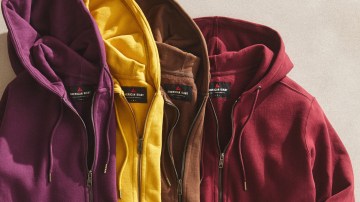In this week’s briefing, a look at new and existing challenges in brand-retailer partnerships. Plus, London retailers are working overtime to win back shoppers, and Coupang, owner of Farfetch, releases earnings. If you have comments on this briefing or tips for future editions, please email me at zofia@glossy.co.
The luxury wholesale landscape is undergoing significant shifts as brands adjust to stricter retailer payment terms, evolving consumer preferences and the dominance of larger luxury players. Recent changes to the payment policies of Saks Global have, for many brands, intensified pressures, prompting a reevaluation of wholesale strategies.
On February 14, Saks Global parent company of Saks Fifth Avenue, Neiman Marcus and Bergdorf Goodman — announced a change to its payment terms, extending them to net 90 days. Starting on March 1, brands will now receive payment 90 days after the retailer receives the inventory, a significant shift from previous arrangements where payments were often made upon shipment or shortly thereafter. Additionally, Saks communicated plans to address past-due balances through 12 monthly installments starting in July 2025. These changes are part of a broader strategy to streamline operations, including reducing the number of vendors by 25% to focus more effectively on remaining brand partners, according to Saks Global.
While net 90 payment terms are not uncommon in the wholesale industry, the application of this policy has raised concerns, especially among smaller brands that rely on timely payments to manage cash flow. In response, Saks Global CEO Marc Metrick stated in a memo to suppliers that the company is willing to work with brands on a case-by-case basis, acknowledging that a one-size-fits-all approach may not be suitable for all partners.
Daniel Saponaro, founder and creative director of Hutch, an independent brand established in 2010, said these developments add to existing wholesale challenges. Hutch launched in Neiman Marcus in February and is also stocked at Saks and Bloomingdale’s. Saponaro declined to share revenues. He emphasized the financial strain that extended payment terms can impose, particularly on independent brands without substantial financial backing.
“Retailers are asking more of brands than ever before: faster deliveries, more exclusives and, now, longer waits for payment,” he said. “It’s a lot to juggle, and for smaller businesses, it can be crippling.”
Despite these hurdles, Hutch remains committed to its wholesale partnerships, with 90% of its business derived from wholesale and only 10% from direct-to-consumer sales.
“A lot of brands have moved to DTC, but for us, it’s not the right play,” he said. “We’ve built these [retailr] relationships over a decade. We’ve been in some of our specialty store accounts for 10-12 years. Why would we turn our back on that?”
According to Saponaro, one of the biggest challenges working with department stores is that they all operate differently.
“Nordstrom is broad — everyone shops there, so we take a mix of price points. Neiman Marcus is luxury — they want showstoppers. Bloomingdale’s cares about size inclusivity, which has been a core part of our business since 2014,” he said. “At Saks, we’re in a completely different category than at Neiman’s. They’re all [operating] differently, which is great, but it also means you have to be hyper-aware of what’s working and what’s not.”
Even with solid retailer partnerships, brands are finding that the lack of data transparency they provide is a challenge. “We know what our best sellers are, but we don’t get granular insights into who’s buying, how often they’re returning and what else they’re shopping for,” Saponaro said. “That information is gold, and right now, the retailers hold all the cards.”
Saponaro also acknowledged that a brand’s production and logistics have to be airtight in today’s wholesale climate. “You can’t go into these deals unless you have your production in order. If something ships late, it gets marked down before it even hits the floor,” he said. “We can turn around reorders in six weeks, and that’s a huge advantage for us. A lot of brands can’t do that.”
Still, Saponaro remains optimistic about wholesale’s future. “It’s not easy, but it’s still the best way to grow a brand at scale,” he said. “If you make the right product and manage your relationships, there’s still opportunity in department stores.”
How London retailers are evolving to return to growth
U.K. luxury retail is undergoing a transformation as retailers aim to rebuild their post-Brexit shopper base.
At a London Fashion Week event, Judd Crane, executive director of buying and brand at Selfridges, said shifts in VAT policies have transformed the U.K. retail landscape. “Our business is now 80% domestic, up from 65% before Brexit,” he said. “The biggest decline we’ve seen is in luxury leather goods. Shoppers who used to buy their investment bags here are now doing it in Paris, Milan or elsewhere in the E.U.”
In turn, Selfridges is doubling down on experiential retail. Over the past two years, the company has hosted rotating luxury brand showcases, from Prada’s Magnum Photos collab to Versace’s Icons experience. It has also partnered with sneaker repair company Sneakers ER and repair app SOJO.
“Experiential retail isn’t a buzzword for us. We had the first public exhibition of a television,” Crane said. “We displayed the first airplane to fly over the Atlantic. We are constantly asking: What should a store be, and how can we reinvent it?”
Will Wyness, head of creative vision at Selfridges, echoed the sentiment. “We see ourselves not just as a department store, but also as a destination and a center of pop culture,” Wyness said. “It’s really a time for in-real-life experiences. People want to engage with fashion and culture in new ways, beyond just shopping.”
Sixteen-year-old London concept store Machine A has been curated a cutting-edge mix of independent designers — i.e., Raf Simons, Grace Wales Bonner and Kiko Kostadinovand — and CSM graduates since its inception. Regarding the store’s draw, Stavros Karelis, founder and buying director of Machine A, said, “We’re giving young designers a space to be seen, to have a moment.”
But Karelis also spoke about the impact of Brexit on independent retail. “Brexit hit us hard, especially in the first year, when brands were unsure how to ship to us. We had collections stuck in customs for weeks,” he said. “But we pushed through. If there’s one thing London retail has, it’s resilience.”
Ida Petersson, co-founder of the Good Eggs fashion agency, agreed. “It’s been a really challenging time, and not just in the U.K., but in the world,” she said. “The U.K. has had it even tougher because of VAT removal, which definitely changed who the customer is. A lot of retailers had to adapt how they communicate with consumers, [direct] their customer journey, and so on.”
Brands agree that retail has become a tough market. “Luxury retailers are playing it safe, focusing on big names, but where does that leave the next generation of designers?” said Adrian Gordon, gallery director at luxury eyewear brand Jacques Marie Mage, which is opening its first London store this month. “People don’t just want to buy products anymore — they want an experience, a connection. That’s why physical retail has to evolve.”
Earnings: Coupang’s Farfetch bet pays off, but what’s next?
Coupang is starting to see returns on its Farfetch acquisition, but questions remain about the luxury marketplace’s long-term fit within the Korean e-commerce giant.
In its fourth-quarter 2024 earnings call on Monday, Coupang reported that Farfetch has gone from losing hundreds of millions of dollars annually to breaking even.
“We made tough decisions with the aim of simplifying operations and refocusing the teams on the only two things that truly matter: customer experience and operational excellence,” said Coupang founder and CEO Bom Kim.
Coupang acquired Farfetch in early 2024 when the luxury platform was struggling with declining growth and heavy losses. Since then, Coupang has cut costs, streamlined operations and applied its logistics expertise to stabilize the business. The result: Farfetch still attracts 49 million monthly visitors across 190 countries, and its financials are no longer bleeding.
Coupang stopped short of outlining a long-term vision for Farfetch. The company has yet to announce any major integrations between Farfetch and Coupang’s broader ecosystem, including its fast-growing WOW membership program. The program, launched in 2019, offers benefits like free shipping, access to streaming content and free food delivery. As of the end of 2023, it had approximately 14 million subscribers.
“We’re committed to delivering exceptional experiences for luxury customers, boutiques and brands,” Kim said. “That and operational rigor will set Farfetch on the path to sustainable growth and leadership in the global luxury retail market.”
Executive moves
- Marcona 3, the Milan-based showroom known for launching brands like Off-White and The Attico, is entering a new era under new CEO Paolo Ciarlariello as of February 25. The leadership appointment comes after the September 2024 acquisition of the company by Swiss investment firm Novastone Capital Advisors.
The latest from Glossy
- What’s behind L’Oréal’s niche fragrance investments
- How secondhand fashion can benefit from tariffs, new legislation
- How new sustainability guidelines impacted London Fashion Week




